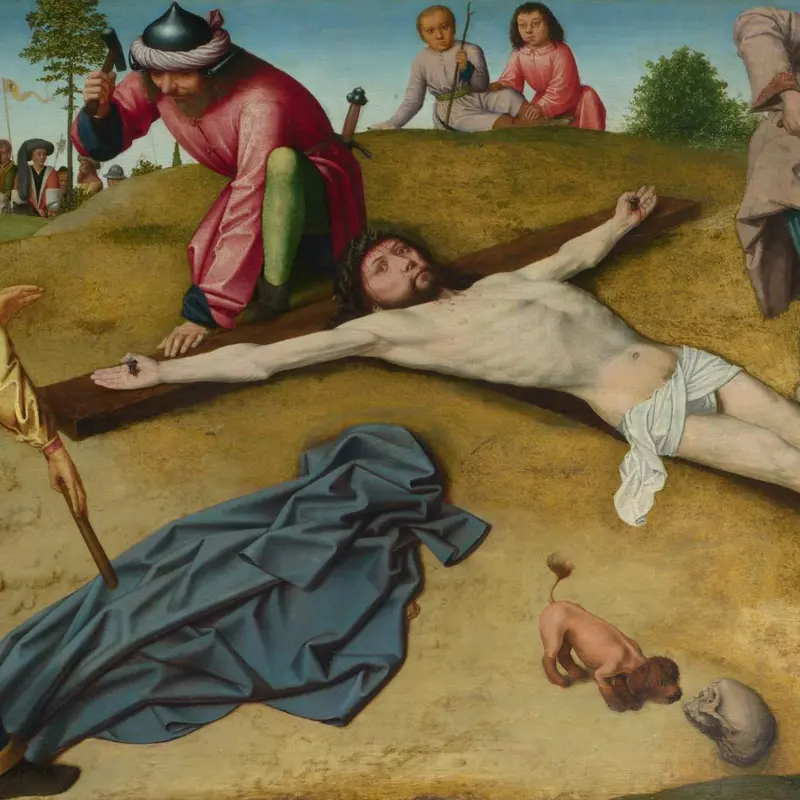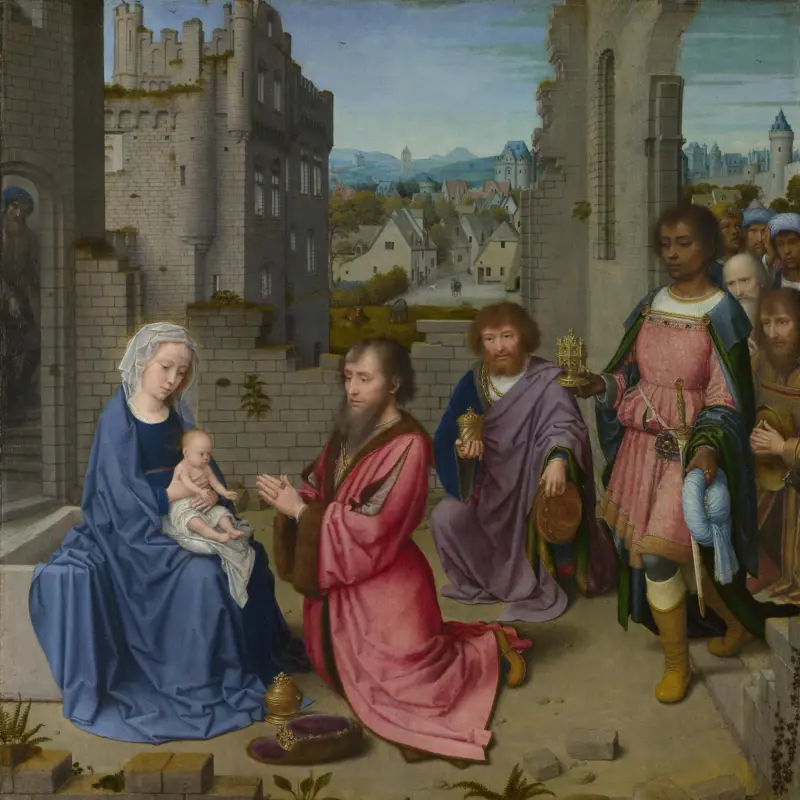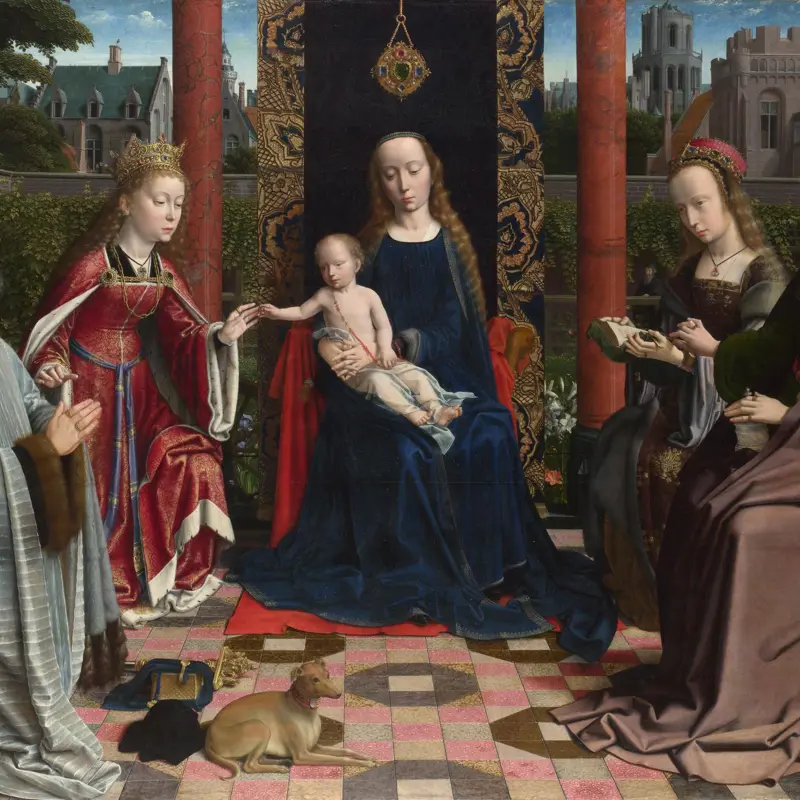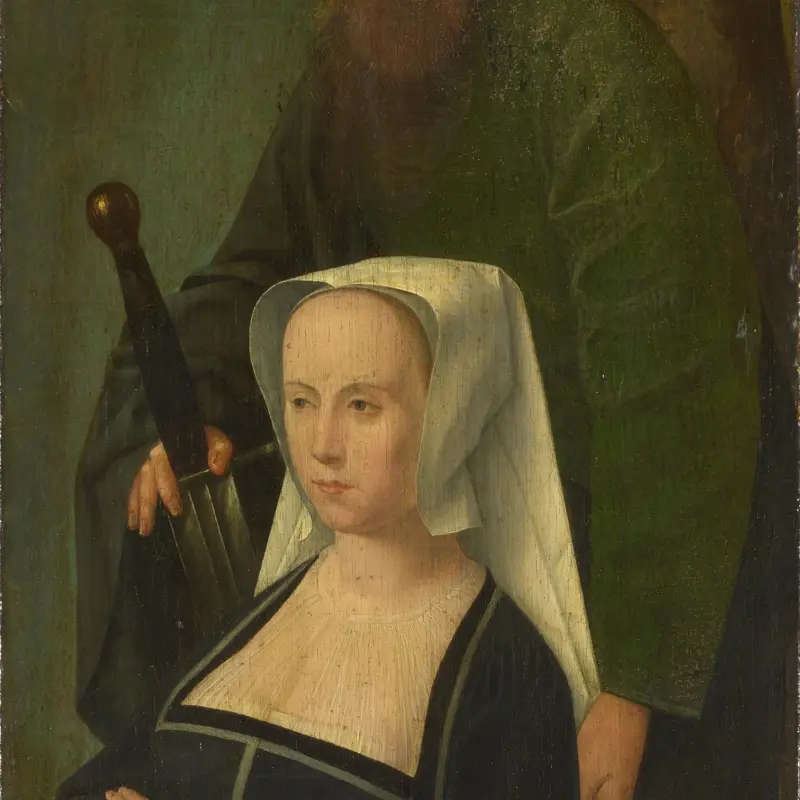Gerard David, 'Christ Nailed to the Cross', about 1481
About the work
Overview
Christ is stretched on the cross on which he is to be crucified – he looks straight at us to invite our sympathy. At his feet, two soldiers haul on ropes to pull his legs straight as another hammers an iron nail into his feet. A fourth knocks a nail into his right hand.
His pale skin and nakedness emphasise Christ’s vulnerability, and David has painted his body with great care: the thin covering of flesh on his distorted chest, the blue veins and taut sinews in his arms and the contorted fingers of his left hand all convey his terrible pain. His face is red, and he seems to be gritting his teeth.
This was once the central panel of a triptych (a painting in three parts). The outer wings are owned by the Royal Museum of Fine Arts, Antwerp.
Key facts
Details
- Full title
- Christ Nailed to the Cross
- Artist
- Gerard David
- Artist dates
- active 1484; died 1523
- Part of the series
- Triptych: Christ nailed to the Cross
- Date made
- about 1481
- Medium and support
- oil on wood
- Dimensions
- 48.4 × 93.9 cm
- Acquisition credit
- Layard Bequest, 1916
- Inventory number
- NG3067
- Location
- Room 53
- Collection
- Main Collection
- Previous owners
- Frame
- 21st-century Replica Frame
Provenance
Additional information
Text extracted from the ‘Provenance’ section of the catalogue entry in Lorne Campbell, ‘National Gallery Catalogues: The Fifteenth Century Netherlandish Schools’, London 1998; for further information, see the full catalogue entry.
Exhibition history
-
2017Gerard David: An Early Netherlandish Altarpiece ReassembledThe Getty Center Los Angeles21 March 2017 - 18 June 2017
Bibliography
-
1849Koninklijk Museum voor Schone Kunsten, Catalogue du musée d'Anvers, Antwerp 1849
-
1862W. Bürger, Musée d'Anvers, Brussels 1862
-
1865A. Michiels, Histoire de la peinture flamande depuis ses débuts jusqu'en 1864, Paris 1865
-
1881Mrs Jameson and E. Eastlake, The History of Our Lord as Exemplified in Works of Art, 4th edn, London 1881
-
1893J. Burckhardt and W. Bode, Der Cicerone, Leipzig 1893
-
1896G. Frizzoni, 'La Galerie Layard', Gazette des beaux-arts, II, 1896, pp. 455-76
-
1899M. Friedländer, 'Malerei, Niederländer und Deutsche', in Ausstellung von Kunstwerken des Mittelalters und der Renaissance aus Berliner Privatbesitz veranstaltet von der Kunstgeschichtlichen Gesellschaft …1898, Berlin 1899, pp. 12-14
-
1902G.H. de Loo, Exposition de tableaux flamands des XIVe, XVe et XVIe siècles: Catalogue critique, précédé d'une introduction sur 'identité de certains maîtres anonymes, Ghent 1902
-
1902E. Durand-Gréville, 'Correspondence de Belgique', Chronique des Arts et de la Curiosité, XXXV, 1902, pp. 279-81
-
1903A.H. Layard, Sir A. Henry Layard, G.C.B., D.C.L.: Autobiography and Letters, ed. W.N. Bruce, London 1903
-
1903F. Dülberg, 'Die Ausstellung der Altniederländischen Meister in Brügge', Zeitschrift für bildende Kunst, XIV, 1903
-
1905S. Reinach, Répertoire de peintres du Moyen Âge et de la Renaissance (1250-1580), 4 vols, Paris 1905
-
1911E. Bodenhausen and W.R. Valentiner, 'Zum Werk Gerard Davids', Zeitschrift für bildende Kunst, XXII, 1911
-
1911L. de Fourcaud, 'La fin de l'art primitif à Bruges: Gerard David', Revue de l'art ancien et moderne, XXX, 1911
-
1913F. Winkler, 'Gerard David und die Brigger Minaturmalerie seiner Ziet', Monatschefte für Kunstwissenschaft, VI, 1913
-
1915F. Winkler, 'Studien zur Geschichte der nierderländischen Minaturmalerei de XV und XVI Jahhunderts', Jahrbuch der Kunsthistorischen Sammlungen des allerhöchsten Kaiserhauses, XXXII/3, 1915, pp. 279-342
-
1924M.J. Friedländer, Die altniederländische Malerei, 14 vols, Berlin 1924
-
1927L. Demonts, 'L'exposition l'art flamand à la Royal Academy de Londres', Gazette des beaux-arts, XV, 1927, pp. 264-5
-
1929F. Dülberg, Niederländische Malerei der Spätgotik und Renaissance, Berlin 1929
-
1936V. Bloch, 'From van Eyck to Brueghel', The Burlington Magazine, LXVIII, 1936, pp. 92-5
-
1936H. Gerson, 'Jerome Bosch and the North-Netherlandish Primitives', The Burlington Magazine, CXIX, 1936, pp. 136-7
-
1938T. Bodkin, 'The Reconstruction of Dismembered Masterpieces by International Action', in XIVe congrès international d'histoire d'art: Actes du congrès 1936, Bâle 1938, vol. 2, pp. 205-6
-
1945Davies, Martin, National Gallery Catalogues: Early Netherlandish School, London 1945
-
1949T. van de Walle de Ghelcke, Gerard David, Phd Thesis, Univeristy of Louvain 1949
-
1953M. Davies, The National Gallery, London, Les Primitifs flamands. I, Corpus de la peinture des anciens Pay-Bas méridionaux au quinzième siècle 3, 2 vols, Antwerp 1953
-
1955Davies, Martin, National Gallery Catalogues: Early Netherlandish School, 2nd edn (revised), London 1955
-
1955M. Davies, 'A Reminiscence of van Eyck by Gerard David?', Bulletin des Musées Royaux des Beaux-Arts, IV, 1955, pp. 173-5
-
1965S.J. Gudlaugsson, 'Gerard David', in G. Bazin et al., Kindlers Malerei Lexikon, Zürich 1965, pp. 34-7
-
1967M.J. Friedländer, Early Netherlandish Painting, eds N. Veronée-Verhaegen and H. Pauwels, trans. H. Norden, 14 vols, Leiden 1967
-
1968C.D. Cuttler, Northern Painting from Pucelle to Bruegel: Fourteenth, Fifteenth and Sixteenth Centuries, New York 1968
-
1970P. Philippot, Pittura fiamminga e Rinascimento italiano, Turin 1970
-
1971E.K. Sass, Comments on Rembrandt's Passion Paintings and Constantijn Huygens's Iconography, Copenhagen 1971
-
1972E.K. Sass, Pilate and the Title for Christ's Cross in Medieval Representations of Golgotha, Copenhagen 1972
-
1972L. Wuyts, 'Quod scripsi, scripsi. Ikonologische aantekeningen bij een werk van Gerard David', Jaarboek Koninklijk Museum voor Schone Kunsten Antwerpen, IX, 1972, pp. 87-100
-
1973The National Gallery, The National Gallery: January 1971 - December 1972, London 1973
-
1975D.G. Scillia, Gerard David and Manuscript Illumination in the Lowlands, Phd Thesis, Case Western Reserve University 1975
-
1980E.J. Mundy, Gerard David Studies, Princeton 1980
-
1980J. Mills and R. White, 'Analyses of Paint Media', National Gallery Technical Bulletin, IV, 1980, pp. 65-7
-
1984L. Silver, The Paintings of Quentin Massys with Catalogue Raisonné, Oxford 1984
-
1985O. Vandebroeck, Catalogus schilderijen 14e en 15e eeuw, Antwerp 1985
-
1987Davies, Martin, National Gallery Catalogues: The Early Netherlandish School, 3rd edn, London 1987
-
1987D. de Vos, 'Gerard David', in Nationaal biografisch woordenboek, Brussels 1987, vol. 12
-
1989M. Ainsworth, 'Northern Renaissance Drawings and Underdrawings: A Proposed Method of Study', Master Drawings, XXVII, 1989, pp. 5-38
-
1998Campbell, Lorne, National Gallery Catalogues: The Fifteenth Century Netherlandish Paintings, London 1998
-
2001
C. Baker and T. Henry, The National Gallery: Complete Illustrated Catalogue, London 2001
About this record
If you know more about this work or have spotted an error, please contact us. Please note that exhibition histories are listed from 2009 onwards. Bibliographies may not be complete; more comprehensive information is available in the National Gallery Library.
Images
About the series: Triptych: Christ nailed to the Cross
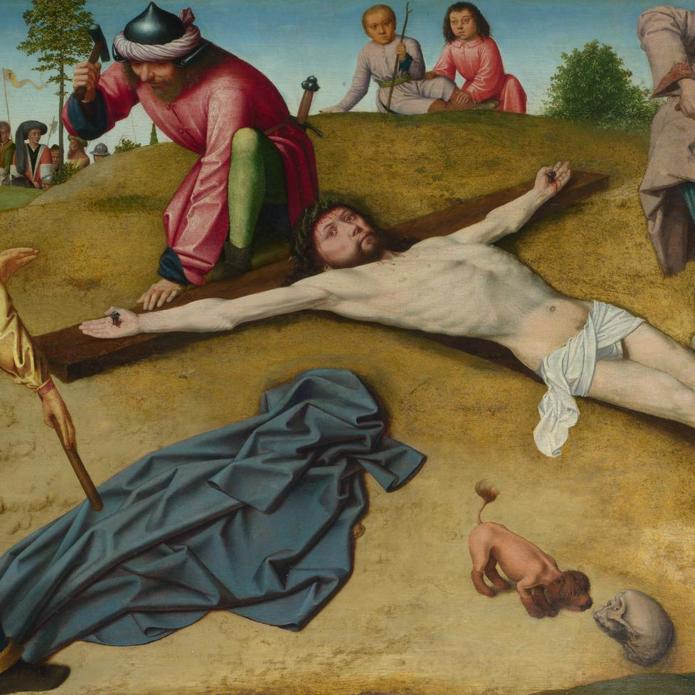
Overview
This painting was once the centre of a triptych (a painting in three parts), and was originally flanked by Pilate and the Chief Priests on the left and The Virgin, Saint John the Evangelist and the Three Marys on the right (both now owned by the Royal Museum of Fine Arts Antwerp). Together the three panels make sense as a Crucifixion scene, as they include all the characters you would normally find in one.
We don't know when the wings were separated from the central panel. This is one of David’s earliest surviving works, and was probably painted in or after 1491.

